Who would mind bringing the striking beauty of acacia wood into their kitchen? Acacia is an incredibly attractive timber that adds a warm, cozy and inviting feel to any countertop. But is acacia wood suitable for cutting boards?
Well, that’s a common question among home cooks. After all, a good cutting board goes beyond a mesmerizing aesthetic appeal. It should be edge-favorable, long-lasting, non-toxic, easy to care for… and more. So, does Acacia meet all these criteria?
Now, that’s our today’s big question. In this blog, I’ll generously share my knowledge on the subject to help you know if an acacia cutting board is worth bringing into your kitchen. Why not read on to find out?
JUMP TO: Acacia Wood | Good Cutting Board Characteristics | Why Acacia is Good for Cutting Board | How to Care Acacia Wood Board | Acacia Board Comparision With Other Boards | Materials not Suitable for Cutting Board |
- An acacia cutting board is non-toxic, durable, less porous, knife-friendly, and water and rot-resistant.
- You can maintain acacia cutting boards with proper cleaning, oiling, and storage.
- The oils in Acacia make it more resistant to water, rots, and stains than Bamboo.
- Acacia cutting boards are more durable than maple, Bamboo, and Teak.
- Teak is oilier than Acacia and offers better rot and water resistance.
Acacia Wood in Brief
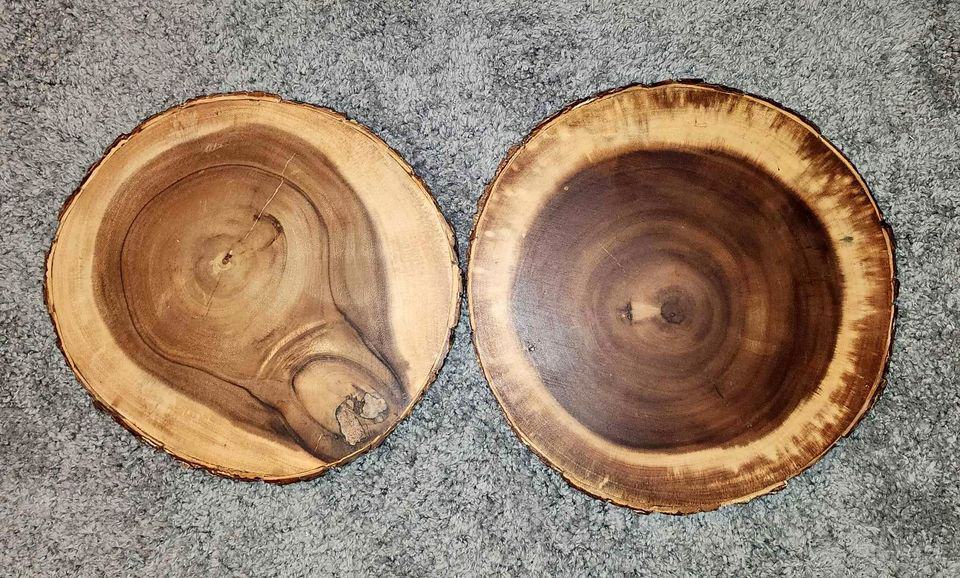
Yes, acacia wood is one of the best materials for cutting boards. This hardwood is dense enough to withstand knife cuts and scrapes. It also offers an antimicrobial surface, making it naturally resistant to bacteria. So, if you’re considering a cutting board, acacia wood fits the bill perfectly.
We’ve all heard about the hundred-and-one uses of Acacia. Woodworking, medicine, and baking… and these are just some areas where it finds its use.
But that’s not all!
And among the other applications of acacia wood is making cutting boards.
Sure, it may not be the most common material for cutting boards. But then again, it undoubtedly makes a great cutting board.
No wonder it’s often used in luxury kitchens!
And so, here comes the question: Was Acacia giving it such a unique edge?
Well, we’ll slowly find out below.
But just before we do…
Let’s look at what makes a great cutting board.
Related Read: Acacia Vs. Bamboo Cutting Board
Characteristics Of A Good Cutting Board
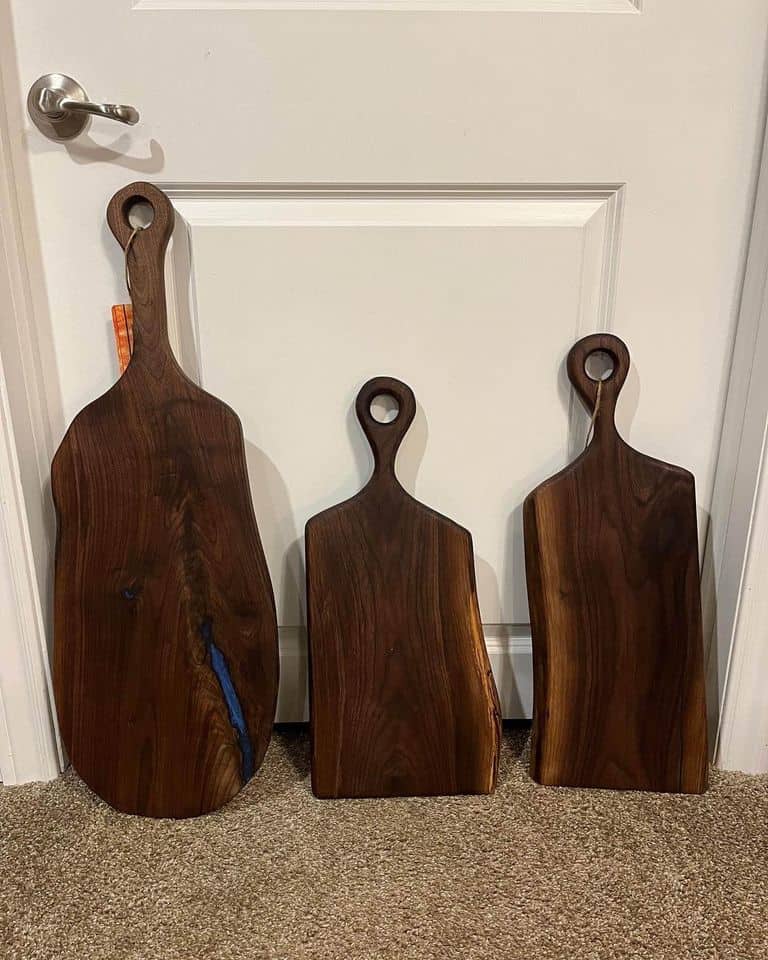
When shopping for a cutting board, paying attention to a few factors ensures that you make the ideal choice. Remember that a chopping board is one purchase that, when made right, you may never have to worry about buying another cutting board for decades.
With that said, a good and safe cutting board should be:
Non-toxic
The toxicity aspect comes first – and for a reason! It’s that one area you just can’t afford to compromise on!
In fact…
It’s probably the essential factor when acquiring a cutting board. A slight mistake here can be detrimental to your health and expensive for your wallet.
Hard and durable
A cutting board doesn’t just hold what you’re cutting. It also takes the brunt of your knife. It’s where your knife blade’s impact has, so it’s only practical to pick something hard and durable.
And by “hard and durable,” I mean that you need something that can withstand years of cutting and chopping without splitting or cracking. Otherwise, some sharp pieces of wood could find their way into your food, something you don’t want.
Low Porosity
Porosity is just what the name says – the degree to which a material has pores or tiny cracks. And for chopping boards, nonporous surfaces are the most hygienic. They prevent liquids, bacteria, and other contaminants from seeping in.
But unfortunately, wood is naturally porous. In other words, no single wood is nonporous.
Even so, the degree of porosity differs!
And that’s where this factor comes in!
When buying a wooden cutting board, get one with the lowest possible porosity. It will still absorb moisture and residue from your cutting, but not as much as other more porous wood types.
Extra Features
The other factor you need to bring into play is extra features. Well, wooden cutting boards may not offer lots of these. However, plastic boards tend to offer a few more bells and whistles.
Some of these extras include;
- Non-slip grips
- Calibrations
- Handles
- Grooves around the edge for collecting any juices when cutting.
- Dishwasher safety
Now that we’ve examined the qualities of a great cutting board let’s find out how Acacia wood fares in each of these.
Also Read:
Why Is Acacia a Great Choice For Cutting Boards?
We’ll dig into its features to examine the suitability of acacia wood for cutting boards. That includes its strength and durability, water and rot-resistance capabilities, and how friendly it is to knives. Of course, we’ll also examine the pros and cons of having one as the ideal cutting board material.
Acacia Wood Properties
It Is Non-Toxic
Yes, acacia wood is non-toxic wood that won’t leach any toxic substances into your food. In fact, the FDA has approved it as a food-safe material. As such, you can expect acacia wood to serve you well without contaminating whatever you place on it.
Acacia Wood Strength & Durability
Acacia is one of the hardwoods, just as aforementioned. And in fact, it’s one of the hardest, rated at 2,300 pounds of force on the Janka hardness test scale.
Wait a minute… what’s the Janka hardness scale?
Well, it’s a scale measuring the hardness and strength of different materials. It takes into account the amount of force needed to leave a dent in the material.
That means it takes just as much amount of force (2300 lbf) to create an indentation on this wood. That means that Acacia is 55% harder than the European White Oak. That’s why you can even use it as a butcher block.
But then again…
Know that we’ve got over 1350 species of Acacia.
That’s a whopping number, right?
Well, that means the hardness of each species is different. Some are rated as low as 1170 lbf, bringing the average to about 1750 lbf.
It all depends on the species, climate, age of the tree, soil, cutting season, and other factors that affect its hardness.
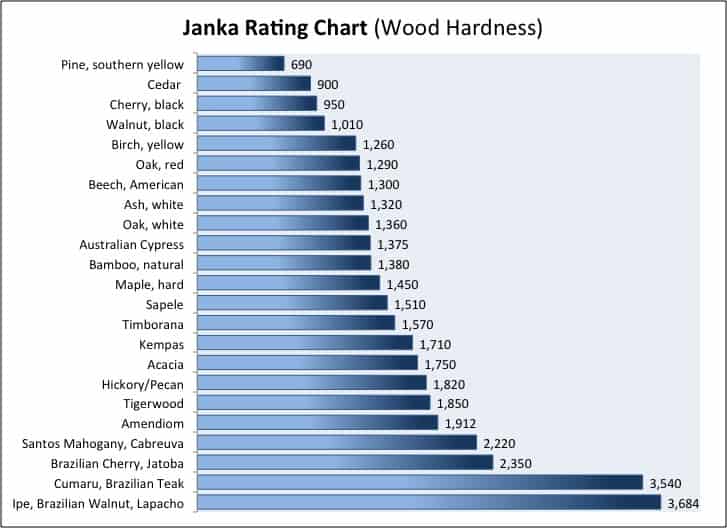
Source: Flowers flooring
Water Resistance & Rot Resistance
Who wants something that would soak up liquids that come with food prep? Of course, NOBODY – right?
And that’s why water resistance is one of the key properties you should consider.
And Acacia has it.
Even with the low water content, Acacia isn’t a “water thirsty” wood as its density is 670 kg/m³ to 800 kg/m³. The higher density means it’s less likely to absorb water and liquids as well. And, of course, its oils make it even more water-resistant naturally.
In fact, that’s why Acacia trees survive hurricanes and serve well for outdoor furniture, even without special treatment. Plus, it has natural oils that give it natural water resistance.
Rot Resistance
Rot is a significant enemy of wood, especially in cutting boards. But luckily, Acacia has natural oils that help protect it from rotting.
Perhaps you’re wondering…
“How do oils prevent rotting?”
Well, it’s easy! The science is :
You see, fungi are attracted to more humid places. And oils help reduce the humidity in Acacia, making it less attractive to fungi and bacteria.
Knife Friendly
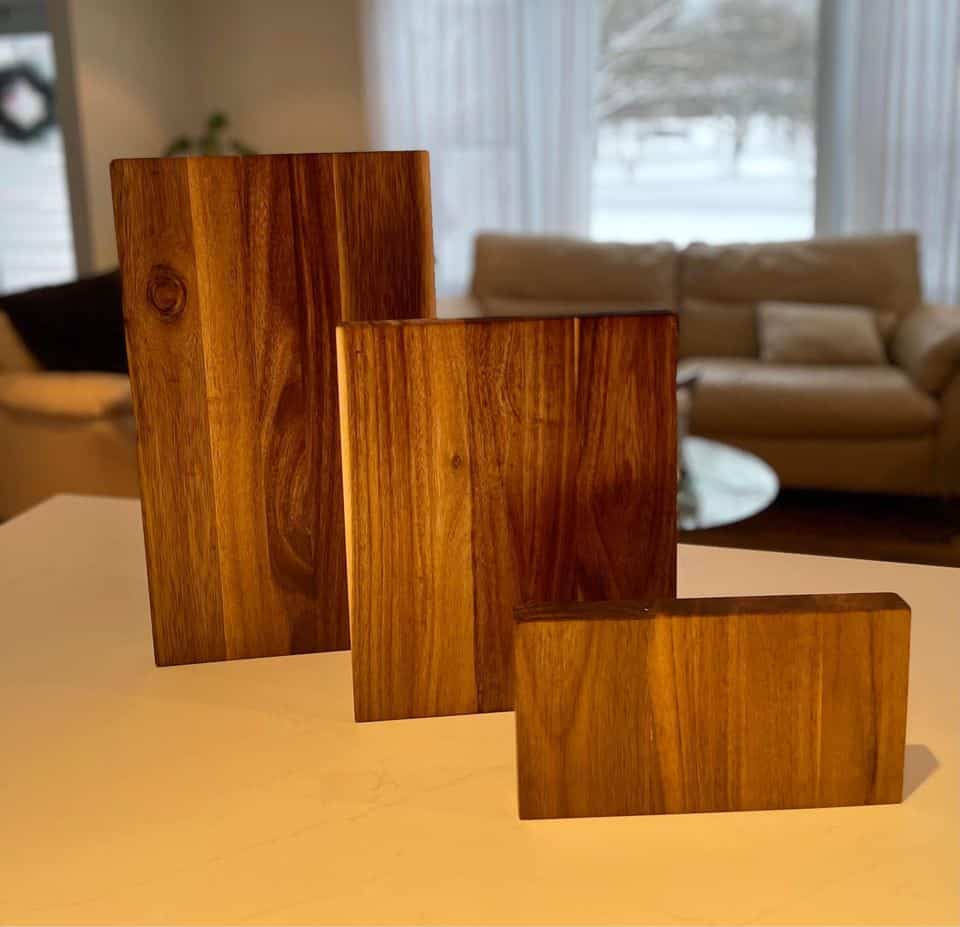
We all need to keep our knives’ edges sharp. After all, several studies confirm a sharper edge is less dangerous for use than a dull one. That’s why when getting a cutting board, go for one that retains the cutting edge of your knife.
And Acacia is one of those boards!
Well, it’s not that it actually sharpens your knives. It’s just that it comes with the right amount of hardness that doesn’t split and, simultaneously, doesn’t dull your knives quickly.
Pros And Cons Of Acacia Cutting Boards
To get a better understanding of these boards, let’s take a look at the advantages and disadvantages they present.
Pros
- Non-toxic
- Beautiful
- Durable and strong
- Water and rot resistance
- The nonporous surface makes cleaning it a breeze
- Retains the cutting edge of knives
- Easily available in markets
- Easy to finish
Cons
- Some species can be softer than others
- It can be expensive compared to other materials
- Damages when exposed to products like alcohol, scrubbing pads, and silicone-based products.
- Uneven consistency of color
Acacia Wood Cutting Board – Maintenance
Even with the durability of Acacia and all its delightful properties, proper care is vital to prolonging the life of your cutting board. Improper maintenance can significantly reduce the life of your board.
Here are a few tips to help you maintain your Acacia wood-cutting board:
Also Read: How to Season A Cutting Board? [Simple Steps Explained]
Regular Cleaning
This is an obvious way of maintaining most kitchen items, including your Acacia cutting board. Dirt is an enemy of durability.
So, take time and give your board a proper cleaning. Use mild soap and lukewarm water for cleaning. This combo works well and won’t compromise your cutting boards’ properties.
And if you love using bleach, you’re in the clear to use it.
But there’s a catch… Always rinse your board properly after you’re done. Otherwise, it can spoil the wood’s flavor.
Again, avoid leaving your board in soapy water for extended periods when cleaning. Keep in mind that Acacia is only water-resistant but not waterproof. So, when left in the water, it can absorb it and get damaged.
Lastly, still, on cleaning, use soft water. Hard water features minerals, which could leave a deposit on the wood after it dries.
But that doesn’t imply you can’t use hard water for the job. You still can. But that comes with more work. If you’re using it, apply vinegar to neutralize the minerals after each cleaning session.
Proper Oiling
Another essential maintenance hack is oiling your Acacia cutting board regularly. Of course, Acacia is a naturally oily wood. Nonetheless, you still need to oil it from time to time for better service and durability. You can use it once every fortnight.
For this task, you need mineral or vegetable oil. Applying the right amount of oil enhances the water and rot-resistance properties of the wood. It also ramps up the overall visual appeal of the wood grain.
Proper Storage
Finally, the last thing that your board needs is what almost every item needs; proper storage.
When not in use, keep an Acacia cutting board in a cool but dry place. Avoid areas with high temperatures and humidity, as this can compromise the board’s properties. The same goes for direct sunlight.
How Do Acacia Cutting Boards Compare To Other Types?
Now that we’ve looked at the pros and cons of Acacia cutting boards, let’s compare them to other types. How do they compare to other materials currently on the market?
Well, let’s take a look:
Acacia Vs. Bamboo Cutting Boards
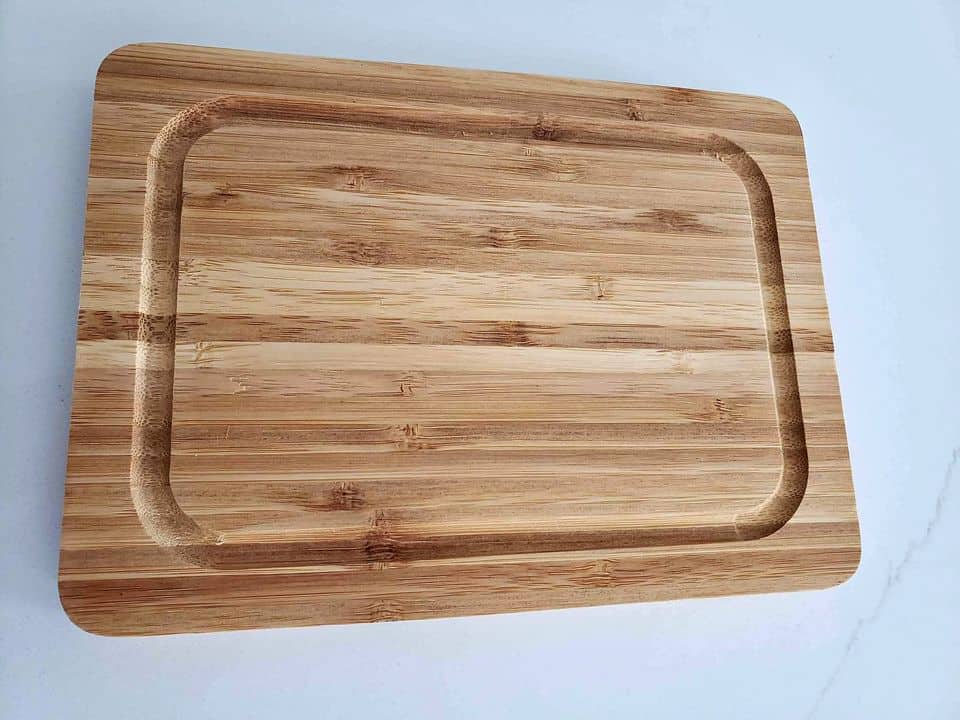
Acacia and Bamboo are all in the category of hardwoods. But they vary slightly in durability and other features.
On durability, Acacia has the edge over Bamboo. It’s naturally more durable than its counterpart. Other areas where Acacia outshines Bamboo are in water resistance. Unlike Bamboo, which uses its higher density for water protection, Acacia has natural oils to keep it dry.
Lastly, another factor that puts Acacia ahead of Bamboo is knife sharpness. When cutting with a bamboo board, you’ll likely find your knives getting duller faster. With Acacia, that’s not the case. But, of course, that doesn’t make Bamboo any bad. In fact, it’s an eco-friendly material and is even a renewable resource.
Acacia Vs. Maple Cutting Boards
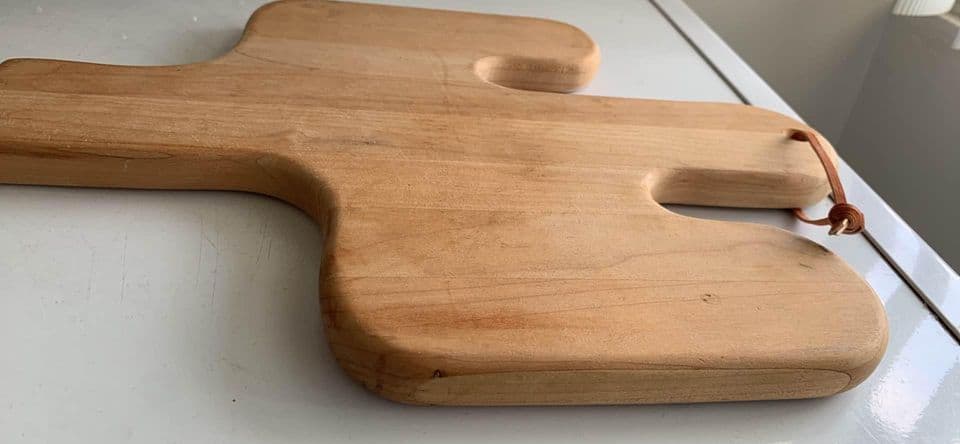
Before I proceed with the comparison, Maple cutting boards are also regarded as being very good. But when you compare it to Acacia, there’s a clear difference in performance.
Durability-wise, Acacia is more durable than maple. It’s also better at resisting rot compared to its counterpart. But that doesn’t suggest that maple will rot quickly. It just needs more care and maintenance to last a long time.
Teak Vs. Acacia Cutting Boards
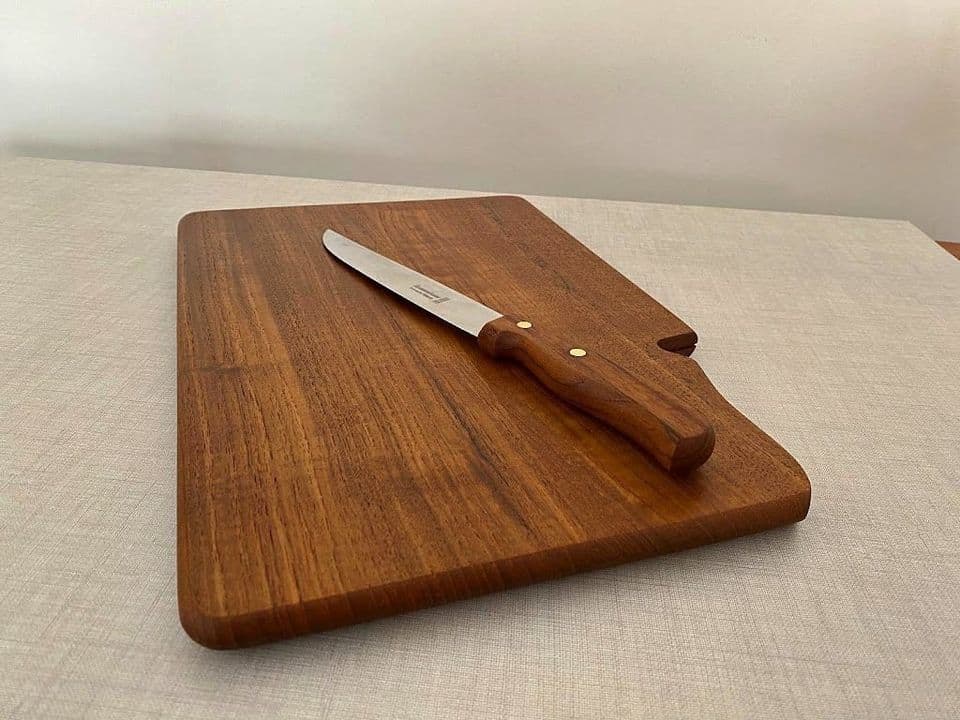
On hardness and durability, Teak is no match for Acacia. Teak wood has a Janka rating of 1000, while the “softest” Acacia species has a Janka rating of 1700. And believe me, 700 is enough to make a massive difference.
That said, Teak offers better water and rot resistance than Acacia. Well, that’s because it contains more oil than Acacia. In fact, there’s a very significant gap between the two in this area.
So, which is the better of the two options?
Well, it all depends on what you prioritize more in your cutting board. For a hard, durable cutting board that will last for a long, go for Acacia. But if water and rot resistance is your number one priority, then your guess is as good as mine; Teak is your go-to material.
What Is An Unacceptable Material For A Cutting Board?
The inappropriate material for a cutting board includes soft, porous, and toxic materials. Either of these materials is terrible for the cutting board as they threaten your health and hygiene.
Soft Materials
These materials tend to create crevices that will become the perfect breeding ground for bacteria. They include cedar, redwood spruce, balsa, juniper tree, Douglas fir, and others.
Porous Materials
Porous materials are generally not hygienic since they absorb fluid residue from anything you cut on the chopping board. It becomes impractically impossible to clean porous surfaces. They include mahogany, American black walnut, oak, butternut, and others.
Toxic Materials
Some materials are toxic and may even cause detrimental health benefits when ingested. Some may also affect the overall taste of your food. Examples include western red cedar, pine, birch, Teak, American mahogany, rosewood, and more.
Final Verdict
Acacia is an impressive wooden cutting board material due to its density, natural oils, and sturdy build. Not only can it absorb less liquid than other woods, but it also offers excellent resistance to water and rot. Hence, it’s the perfect option if you want a cutting board that will last you years while being gentle on your knives.
Plus, it’s non-toxic and doesn’t absorb odors or flavors more than necessary. But ensure that you maintain it regularly and take proper safety precautions. That will ensure that you’re getting the best out of your investment.
![Wood Cutting Board Vs. Plastic Board [Which is Safer?] Wood Cutting Board Vs. Plastic Board [Which is Safer?]](https://houseadorable.com/wp-content/uploads/2023/01/wood-board.jpg)
![27 Types of Cutting Boards Explained [Buying Guide Included] 27 Types of Cutting Boards Explained [Buying Guide Included]](https://houseadorable.com/wp-content/uploads/2022/12/cutting-board.jpg)
![Charcuterie Board Vs. Cutting Board [8 Differences] Charcuterie Board Vs. Cutting Board [8 Differences]](https://houseadorable.com/wp-content/uploads/2023/01/316322082_5650827684977137_862859335334204275_n.jpg)
![How to Season A Cutting Board? [Simple Steps Explained] How to Season A Cutting Board? [Simple Steps Explained]](https://houseadorable.com/wp-content/uploads/2022/12/cutting.jpeg)
![Bamboo Vs. Wood Cutting Board [9 Differences Explained] Bamboo Vs. Wood Cutting Board [9 Differences Explained]](https://houseadorable.com/wp-content/uploads/2023/01/cutting-board.jpg)
![How To Care For Bamboo Cutting Board? [Steps+Tips Explained] How To Care For Bamboo Cutting Board? [Steps+Tips Explained]](https://houseadorable.com/wp-content/uploads/2022/12/Bamboo_Heat_Resistant_1.jpg)
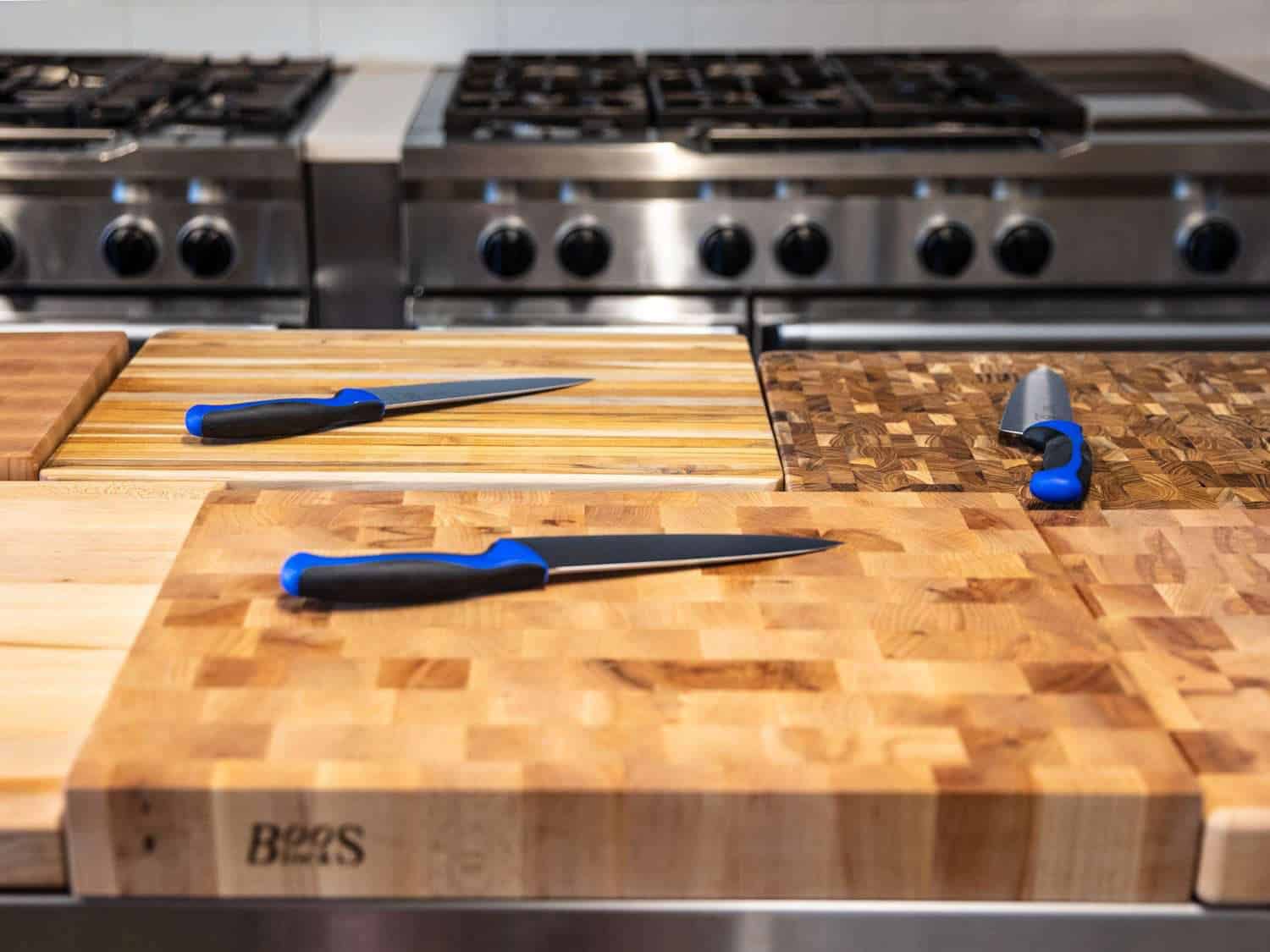
![Acacia Vs. Bamboo Cutting Board [7 Differences Explained] Acacia Vs. Bamboo Cutting Board [7 Differences Explained]](https://houseadorable.com/wp-content/uploads/2022/12/fetured.jpg)